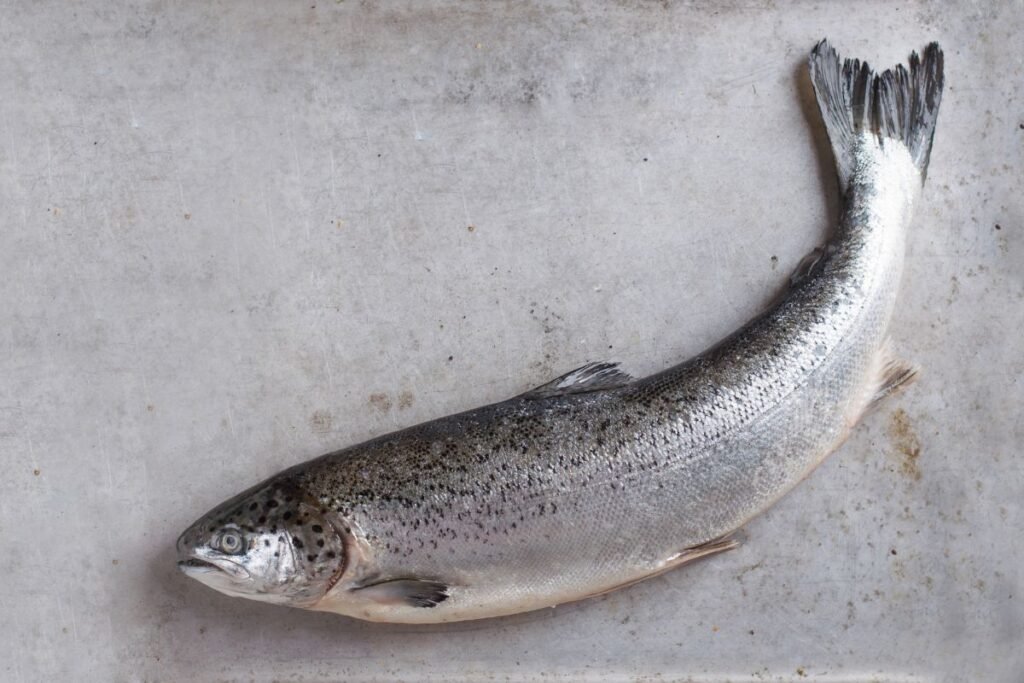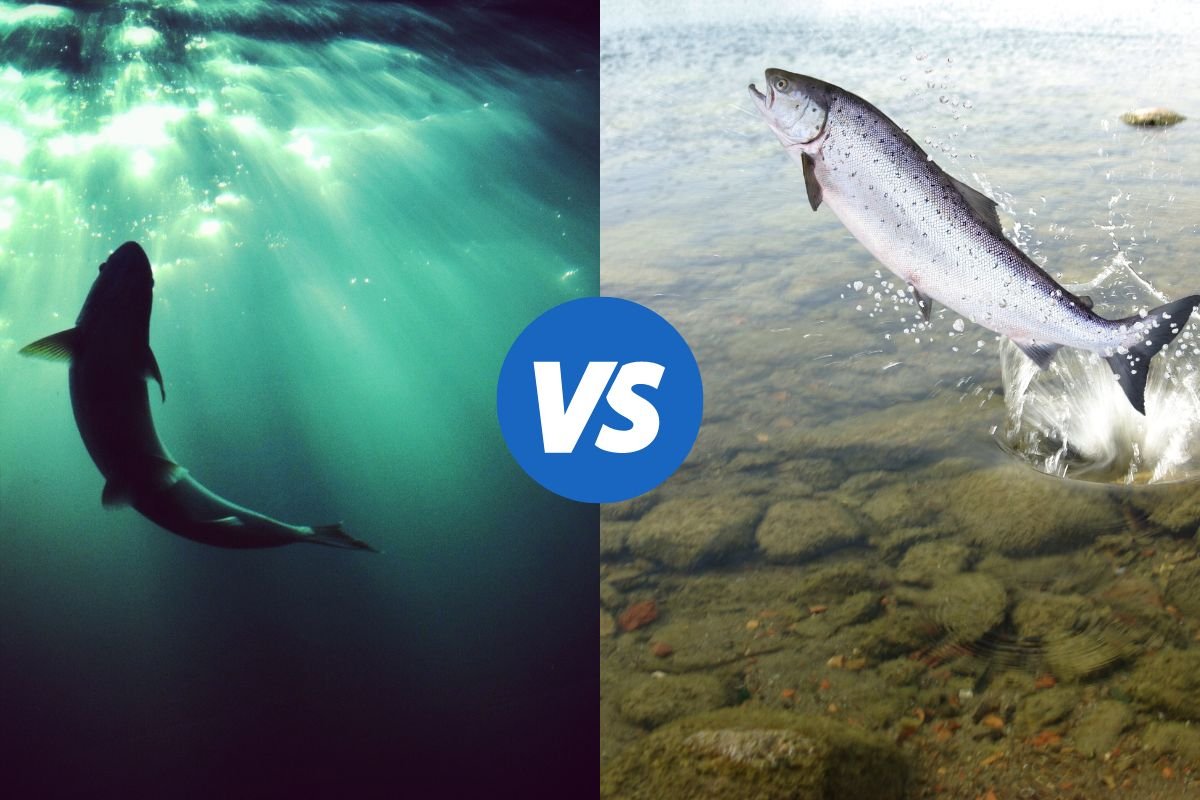One of my favorite memories growing up was trout fishing in the streams in Colorado with my dad. With waiters on, and bait on the end of our lines, we would catch dinner and have a really good time out in nature!
Steelhead Trout vs Salmon: How Do They Compare?
For seafood lovers, steelhead trout and salmon are two popular fish options that share some similarities but also have distinct differences. This comprehensive guide will compare steelhead trout vs salmon when it comes to appearance, taste, nutrition, mercury levels, cost, sustainability, preparation, and more.
Appearance of Steelhead Trout vs Salmon
Though they may look alike at a glance, steelhead trout and salmon have some clear physical differences:
- Color: Steelhead trout have a more muted, silvery gray hue with small black spots along the back and fins. Salmon have a brighter pinkish-orange or reddish color.
- Size: On average, steelhead trout are smaller in size, around 2-6 pounds when caught in the wild. Salmon can grow much larger, sometimes weighing up to 30 pounds.
- Shape: Steelhead trout have a more elongated, torped0-shaped body with a narrow, pointed snout. Salmon have a thicker body and blunter nose.
So while both are elongated, streamlined fish, steelhead trout have a more silver appearance vs the larger, pink-hued salmon. These visual differences help distinguish between the two.

Flavor Differences Between Steelhead Trout and Salmon
In terms of taste profiles, steelhead trout and salmon offer different flavors:
- Steelhead trout have a milder, more delicate flavor compared to salmon. The flesh of steelhead trout is also drier and not as oily or fatty.
- Salmon have a richer, more robust taste, especially wild salmon. The fat content and oil in salmon give it a more distinctive, pronounced flavor.
- Overall, salmon’s taste tends to be stronger, more “fishy,” and fatty compared to the subtle notes of steelhead trout.
So those who enjoy intense, bold fish flavors may prefer the richness of salmon over the muted tones of steelhead trout. But for a milder flavor, steelhead trout is the way to go.
Nutritional Values: Steelhead Trout vs Salmon
Both steelhead trout and salmon provide healthy protein and essential omega-3 fatty acids. But here is how they compare nutritionally in a typical 3-ounce cooked serving:
| Steelhead Trout | Salmon | |
|---|---|---|
| Calories | 144 | 175 |
| Protein (g) | 22 | 25 |
| Total Fat (g) | 5 | 8 |
| Omega-3 Fatty Acids (g) | 1 | 2 |
Looking at this data, salmon contains more calories, protein, total fat, and omega-3s per serving compared to steelhead trout. So when it comes to nutritional content, salmon has the advantage over steelhead trout.
Mercury Level Differences: Steelhead Trout vs Salmon
Mercury exposure is a health concern when eating certain fish. Here is how steelhead trout and salmon compare for mercury content:
| Mercury Level | |
|---|---|
| Steelhead Trout | Moderate |
| Salmon | Low |
Salmon contain low levels of mercury, earning them a green “Best Choice” rating from Seafood Watch when it comes to mercury exposure. Steelhead trout have moderate mercury levels, so should be eaten in moderation.
Cost Differences: Steelhead Trout vs Salmon
On average, wild-caught salmon costs about $2-$3 more per pound compared to steelhead trout. However, farmed salmon is typically cheaper, with pricing similar to steelhead trout. Here are typical cost estimates per pound:
- Steelhead trout: $9-$12
- Wild salmon: $12-$15
- Farmed salmon: $9-$12
So wild salmon tends to be the more expensive choice between the two types of fish. But farmed salmon can be cost-comparable to steelhead trout.
Sustainability of Steelhead Trout and Salmon
When it comes to environmental sustainability, both steelhead trout and salmon face challenges like overfishing and habitat destruction:
- Steelhead trout populations are declining, especially on the West Coast, leading to endangered species protections. Sustainably farmed steelhead is a better option.
- Wild salmon stocks are also diminishing globally. But aquaculture practices are improving for farmed salmon through more sustainable methods.
When purchasing either fish, look for reputable sustainability certifications like Marine Stewardship Council or Best Aquaculture Practices. This supports ethical fishing and farming for both species.

How to Cook Steelhead Trout and Salmon
In terms of preparation, steelhead trout and salmon can be cooked in similar ways:
- Grilling – quick cooking with added smoky flavor
- Baking – gentle heat, retains moisture
- Broiling – caramelized topping from direct heat
- Poaching – delicate poaching in liquid
- Smoking – infuses intense smoky flavor
- Canning – long shelf life when preserved in jars
- Curing – creates gravlax, lox, jerky from the fish
Some chefs say steelhead trout holds up better to high-heat methods like grilling compared to more delicate salmon. But both fish should be cooked carefully to prevent overcooking and drying out.
Key Differences: Steelhead Trout vs Salmon
To summarize, here are some of the main differences to consider when choosing between steelhead trout vs salmon:
- Appearance: Steelhead trout are smaller and grayish, salmon are larger and orange
- Taste: Salmon has a richer, robust flavor vs mild steelhead trout
- Nutrition: Salmon contains more healthy fats, protein, and omega-3s
- Mercury levels: Salmon has less mercury than steelhead trout
- Cost: Wild salmon is more expensive than farmed or steelhead trout
- Sustainability: Both face fishing pressure but salmon aquaculture is improving
- Preparation: Both can be cooked similarly, but steelhead may withstand higher heat
So while the two fish share some attributes, there are important contrasts in taste, nutrition, mercury content, cost, and cooking methods. Those seeking a bold, fatty fish taste may prefer salmon while milder steelhead trout costs less. Both can provide stellar nutrition when sourced sustainability.
Want to see more fish comparisons? Check out Pollock Vs Cod
Conclusion: How to Choose Between Steelhead Trout vs Salmon
When deciding between steelhead trout vs salmon, consider your taste preferences, budget, nutrition goals, and concerns about sustainability and mercury exposure.
While salmon offers more omega-3 fatty acids and protein, steelhead trout has a milder flavor and costs less, especially when farmed. Seeking out reputable certification programs helps support responsible fishing practices for both species.
With their impressive nutrient contents, steelhead trout and salmon can be delicious, healthy seafood choices. The key is choosing the variety that best aligns with your needs and preferences.
While I have fond memories of trout, it is salmon that I prefer between the two. Salmon when cooked the way I like it, comes out perfect and delicious!
Which of the two is your favorite? Tell us about it in the comments below.


